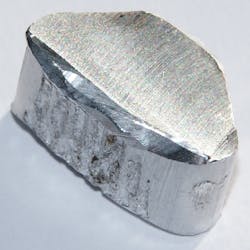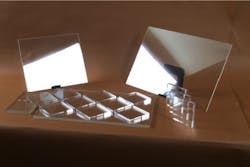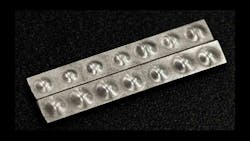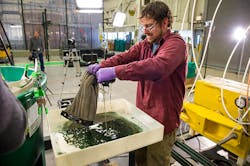Download this article in PDF format.
Aluminum in its modern form has been around for more than a century. In the 1880s, it was considered more valuable than gold, particularly because it was difficult to produce in a pure form. Ever since what is considered the First Age of Aluminum, the metal has become an integral staple of our daily lives in some form or another—vehicles, aircraft, currency, and substrates for electronics such as LEDs are just a few of the examples.
Aluminum refined from bauxite ore. (Courtesy of Images of Elements)
While continuing to be the foundation of our infrastructure, the versatile metal has withstood the test of time, evolving for new and interesting applications ranging from oil and gas cleanup to lighter and faster trains. Its use continues to grow at almost an exponential rate, with the certainty that it will usher in the 21st century as the Second Age of Aluminum and go far beyond what Danish physicist/chemist Hans Christian Orsted could have envisioned when he first refined the metal back in 1825.
Space-Age Material
One of the new ways aluminum is being leveraged comes in the form of Surmet Corp.’s ALON Optical Ceramic, otherwise known as “transparent aluminum.” If that sounds familiar, it’s probably because the term was coined in the movie Star Trek: The Voyage Home. In this case, Surmet developed an aluminum-based ceramic strong enough to stop a .50-cal armor-piercing bullet at close range, yet is lighter and thinner than any bulletproof glass on the market.
Surmet Corp.’s ALON Optical Ceramic plates are also referred to as “transparent aluminum.” (Courtesy of Surmet Corp.)
The key to ALON lies with aluminum oxynitride/ceramic powder, which is heated to a high temperature to liquefy the material and then cooled rapidly to scatter the molecules and leave them frozen in that scattered state. This gives the material its strength and scratch resistance that’s comparable to the hardness of a sapphire. The material is then molded into nearly any desired shape and subsequently sanded and polished to a glass-like level with incredible clarity. The end result is a space-age material that has applications in space/aviation, military, environmental, and transportation industries.
It’s a Wrap
Another interesting development using aluminum comes from researchers at North Carolina State University who used the material to develop their Metallic Cushioning material. Otherwise known as Aluminum Bubble Wrap, the researchers, led by Dr. Afsaneh Rabeiei, developed the material to be stronger than sheet metal while being more heat- and chemical-resistant over other cushioning material such as polymer or plastic.
North Carolina State University’s Metallic Cushioning, or “Aluminum Bubble Wrap,” developed by a research team at North Carolina State Univ., weighs 30% less than sheet metal with the same thickness, but is 50% stronger. (Courtesy of Afsaneh Rabiei)
To create the material, the researchers took a thin sheet of aluminum and then dented it with a studded roller to create uniform pockets. These are then filled with either a calcium-carbonate or titanium-hydrate foaming agent and sealed with another thin sheet of aluminum. This metal sandwich is heated, which decomposes the foaming agent, leaving behind inert bubbles. The result is a wrap that weighs 30% less than sheet metal with the same thickness, and yet is 50% stronger. Potential applications include vehicle body panels, aircraft wings, helmets, and mobile device cases.
Filtering Out Fossil Fuels
Aluminum can also be utilized to help with environmental disasters—in this case, oil and diesel cleanup efforts in river ways, lakes, and oceans. Everyone knows how difficult it is to remove oil from water. Most times, only the surface contaminants are dealt with, leaving a majority of subsurface contaminants unchecked. Scientists from the Argonne National Laboratory developed an aluminum net of sorts that can capture both diesel and oil on and in the water. What’s more, in some cases, the oil and fuel can then be reclaimed and used as if it was straight out of the barrel.
When an environmental disaster strikes involving oil and diesel fuel, Argonne National Laboratory’s Oleo Sponge, a net-like material, can be used to more efficiently clean up these spills. (Courtesy of Argonne National Laboratory)
Argonne’s “Oleo Sponge” was designed using a polyurethane foam. Its interior was then coated with oleophilic molecules using a sequential-infiltration-synthesis (SIS) technique, which allows scientists to grow inorganic materials within polymers. In this instance, it was an aluminum-based metal oxide that acts as a primer for those water-hating, oil-loving molecules to cling to. The resulting material is, in essence, a sponge capable of being wrung out and reused hundreds of times over before breaking down.
With all of the developments made possible by using the lightweight metal, it’s clear to see why this age is becoming known as the Second Age of Aluminum. Its properties will undoubtedly help foster new technological breakthroughs and continue to serve as a lasting reminder of why we built an entire civilization on its foundation.
About the Author
Cabe Atwell
Engineer, Machinist, Maker, Writer. A graduate Electrical Engineer actively plying his expertise in the industry and at his company, Gunhead. When not designing/building, he creates a steady torrent of projects and content in the media world. Many of his projects and articles are online at element14 & SolidSmack, industry-focused work at EETimes & EDN, and offbeat articles at Make Magazine. Currently, you can find him hosting webinars and contributing to Penton’s Electronic Design and Machine Design.





